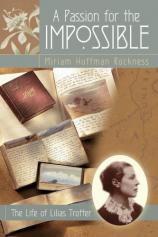A Passion for the Impossible: The Life of Lilias Trotter
Review
A Passion for the Impossible: The Life of Lilias Trotter
As the premier art critic in Victorian England, John Ruskin was the arbiter of taste. In 1883 he revealed a hard-to-believe prejudice: "For a long time I used to say... that except in a graceful and minor way, women could not draw or paint." Ruskin then discounted this view, based on his reaction to the art of a young woman named Lilias Trotter: "I'm beginning lately to bow myself to the much more delightful conviction that no one else can" draw or paint.
In a 1960s book, RUSKIN TODAY, Sir Kenneth Clark mentioned Trotter as someone lost to history. But Clark hadn't turned over every leaf, as has biographer Miriam Rockness, who discovered Trotter through bequeathed volumes of her out-of-print illustrated books.
A bright, talented daughter of a prominent stockbroker in London, Lilias Trotter (1853-1928) was comfortable in the company of privilege. At age 21 she was among guests, including George MacDonald and Bishop Wilberforce, invited to a religious retreat, the forerunner of the Keswick Conferences.
Spiritually stirred by this and the preaching of Dwight Moody, Lilias grew discontent with the in-vogue "charity from a distance." For more than 10 years in London, she devotedly worked to help establish a hostel for working women, the forerunner of the YWCA.
During this time, while on vacation in Venice, her meddling mother asked Ruskin to look at Lilias's watercolor paintings --- a request that led to art lessons, weekend invitations, and extended conversations and correspondence between the Miss and the Master, who claimed she could be the greatest painter of her generation if she would "give herself up to art." To the dismay of many, Lilias turned her back on Ruskin's challenge: "I cannot give myself to painting in the way he means and continue still to 'seek first the Kingdom of God.' "
When Lilias was 35, this whole-spirited commitment dramatically "called" her to mission work in northern Africa. With two female colleagues --- none knowing Arabic, none robust enough to pass physicals required by established mission boards --- she sailed for Algeria, where she lived a life of saintly proportions until her death, at age 75.
Two-thirds of Rockness's biography delves into the Algerian years. Learning Arabic was the first of many challenges: Muslim resistance to a Christian message, French resistance to British interlopers, male resistance to a female witness. And yet under Trotter's leadership, the original missionary band and later recruits translated portions of scripture, distributed literature, befriended women and children, opened cafés for men, and hosted summer camps for nomadic families.
There are no imagined conversations in this book; there's no mistaking it for a novel. This is history, relying largely on journals, with some analysis and helpful foreshadowing. Ever aware of Lilias the artist, Rockness faithfully describes the palette of the desert so well that it's hard to distinguish Lilias the missionary from Lilias the artist.
In time Lilias envisioned a "new approach to Arab literature": writings that would speak to Algerians, instead of what Trotter called the "hitherto translated stories of Jacks & Bobs whose surroundings are as foreign to children of the east as their names" and finding an affordable means of color printing, so as to attract people who delighted in color. To meet these goals, Lilias wrote and illustrated nature parables that may soon be back in print, thanks to Rockness's persistence.
Some of the biography's most interesting material comes toward the end. In her last decade, Trotter won the respect of a group of Sufi (male) mystics. "The artist in her responded to the artist in the Sufis," notes Rockness. "Yet she never lost her spiritual focus." Confined to bed in the last two years, she wrote THE WAY OF THE SEVENFOLD SECRET, explaining to them seven "I Am" claims of Jesus --- as she managed what had become an extensive mission outreach.
Trotter's printed word and art can indeed inspire a new generation. But only those who knew her can appreciate "perhaps her most palpable legacy": her love. As an obituary noted, "No wonder that Catholics and Jews and Moslems, as well as Protestants, are mourning her loss, for love, in the end, wins love."
Reviewed by Evelyn Bence on November 13, 2011



